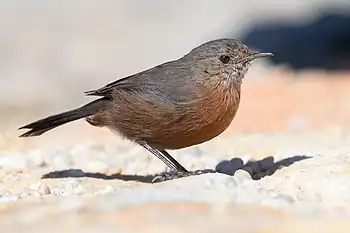Rockwarbler
The rockwarbler (Origma solitaria), is a bird in the family Acanthizidae.[3] It is the only bird species endemic to the state of New South Wales in Australia.[4]
| Rockwarbler | |
|---|---|
 | |
| Scientific classification | |
| Domain: | Eukaryota |
| Kingdom: | Animalia |
| Phylum: | Chordata |
| Clade: | Dinosauria |
| Class: | Aves |
| Order: | Passeriformes |
| Family: | Acanthizidae |
| Genus: | Origma |
| Species: | O. solitaria |
| Binomial name | |
| Origma solitaria (Lewin, 1808) | |
| Synonyms[2] | |
|
Sylvia solitaria, Lewin | |
Taxonomy and systematics
English artist and naturalist John Lewin described the rockwarbler in 1808.[2] For many years it was the only member of its genus until genetic work showed that it was related to two species of mousewarblers from New Guinea. The rockwarbler diverged from the common ancestor of the other two species around 9 million years ago.[5] Rockwarbler has been designated the official name by the International Ornithologists' Union (IOC).[6] Common names also include cataract-bird, cave-bird, origma, rock-robin, and sandstone robin.[2] A former common name, hanging dick, came about from its nest, which hangs suspended in a cave.[7] It has no subspecies.[8]
Description
The rockwarbler is 14 cm (5.5 in) in length and weighs around 14 g (0.5 oz), with predominantly dark grey-brown plumage, darker wings and more red-brown underparts, cinnamon-tinged face and forehead, and whitish throat. Its tail is black.[9] Adult males and females have similar plumage. Juveniles have duller and paler plumage than the adult, with a reddish tint to the throat, and a greyer chin. It can be distinguished from the pilotbird by its smaller size and head, white throat patch, and square tail.[8]
Its main call is a repeated shrill chis-sick, given during the breeding season–though they may also give a tid-ed-dee. Its contact call is rasping and smooth. The alarm call is similar to the contact call, but a single note. Its scold call is a chatter similar to that of scrubwrens. They are accomplished mimics, and will replicate the calls of numerous other birds, including scrubwrens, white-eared honeyeaters, grey butcherbirds, eastern spinebills, rufous whistlers and more.[8]
Distribution and habitat
It is usually seen hopping erratically over rocks while flicking its tail. Its preferred habitat is woodland and gullies with exposed sandstone or limestone rocks, and often near water. Its distribution is central eastern New South Wales, within a 240 km (150 mi) radius of Sydney. It has been affected adversely by human-modified habitat, and has declined in these areas.[9] Most of its range is protected in national parks, which has insulated the species from habitat loss. They generally do not migrate, except in very dry conditions.[8]
Behavior and ecology
Rockwarblers may live alone, in pairs, or in family groups with as many as five members. They do not fly very far, though they are quite fast. Flights tend to be low to the ground. When not flying, they will flick their tail side-to-side.[8]
Breeding and nesting
Mated pairs maintain a territory, nesting in a sandstone cave.[9] The nest is a hanging structure made of grasses, roots, bark and moss, with spider web used as an adhesive. It has a dome-shaped entrance. Breeding season is from August to January. The female lays a clutch of three eggs, which take around 23 days to hatch.[9] Up to two clutches may be laid in a season.[8]
Diet
Rockwarblers are generally insectivores, but will supplement the diet with seeds. Insects are taken mostly on the ground, or in lower branches of vegetation. They may also hover in short bursts to catch prey. They are inquisitive and will investigate nooks and crannies in rocks, as well as under leaf litter. They are nimble, being able to move vertically up rock faces to probe rock features. Preferred insects are ants, wasps, and beetles, as well as butterfly and moth larvae. Panic grass and wheat are both acceptable grains. They will also take food left by humans, namely bread crumbs and butter.[8]
References
- BirdLife International (2016). "Origma solitaria". IUCN Red List of Threatened Species. 2016: e.T22704516A93973568. doi:10.2305/IUCN.UK.2016-3.RLTS.T22704516A93973568.en. Retrieved 15 November 2021.
- Australian Biological Resources Study (5 December 2014). "Species Origma solitaria (Lewin, 1808)". Australian Faunal Directory. Department of the Environment, Water, Heritage and the Arts, Australian Government. Retrieved 5 June 2019.
- Pizzey, Graham; Knight, Frank (2007). Menkhorst, Peter (ed.). The Field Guide to the Birds of Australia (8th ed.). Sydney: HarperCollins. ISBN 978-0-207-19935-6.
- Smith, Peter; Smith, Judy (2012). "Re-use of a Rockwarbler Origma solitaria nest over a 13-year period". Australian Field Ornithology. 29 (2): 77–82.
{{cite journal}}: CS1 maint: multiple names: authors list (link) - Norman, J.A.; Christidis, L.; Schodde, R. (2018). "Ecological and evolutionary diversification in the Australo-Papuan scrubwrens (Sericornis) and mouse-warblers (Crateroscelis), with a revision of the subfamily Sericornithinae (Aves: Passeriformes: Acanthizidae)". Organisms Diversity & Evolution. 18 (2): 241–259. doi:10.1007/s13127-018-0364-8. S2CID 46967802.
- Gill, Frank; Donsker, David, eds. (2019). "Bristlebirds, pardalotes, Australasian warblers". World Bird List Version 9.1. International Ornithologists' Union. Retrieved 21 January 2019.
- "Rockwarbler". Birdlife Australia. Retrieved 7 June 2019.
- Gregory, P (March 2020). del Hoyo, J.; Elliott, A.; Sargatal, J.; Christie, D. A.; de Juana, E. (eds.). "Rockwarbler (Origma solitaria) version 1.0". Birds of the World. Cornell Lab of Ornithology. doi:10.2173/bow.rocwar1.01. S2CID 216273729.
- "Rockwarbler". Birds in Backyards. Birdlife Australia. Retrieved 5 June 2019.
Further reading
- del Hoyo, J.; Elliot, A. & Christie D. (editors) (2006). Handbook of the Birds of the World. Volume 12: Picathartes to Tits and Chickadees. Lynx Edicions. ISBN 978-84-96553-42-2.
External links
 Media related to Origma solitaria at Wikimedia Commons
Media related to Origma solitaria at Wikimedia Commons Data related to Origma solitaria at Wikispecies
Data related to Origma solitaria at Wikispecies
